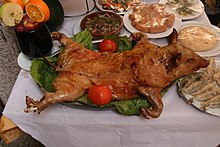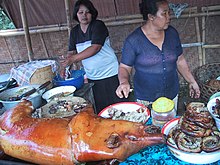Suckling pig


Asuckling pigis apigletfed on itsmother's milk(i.e., a piglet which is still a "suckling"). Inculinarycontexts, a suckling pig isslaughteredbetween the ages of two and six weeks. It is traditionally cooked whole, oftenroasted,in various cuisines. It is usually prepared for special occasions and gatherings. The most popular preparation can be found in Spain and Portugal under the namelechón(Spanish) orleitão(Portuguese).
The meat from suckling pig is pale and tender and the cooked skin is crisp and can be used forpork rinds.The texture of the meat can be somewhat gelatinous due to the amount ofcollagenin a young pig.
History
[edit]There are many ancient recipes for suckling pig fromRomanandChinese cuisine.Since the pig is one of the firstanimals domesticatedby human beings for slaughter, many references to pigs are found in human culture. The suckling pig, specifically, appears in early texts such as the sixth-centurySalic law.As an example of a law governing the punishment for theft, Title 2, article 1, is, in Latin,Si quis porcellum lactantem furaverit, et ei fuerit adprobatum (malb. chrane calcium hoc est) CXX dinarios qui faciunt solidos III culpabilis iudicetur."If someone has stolen a suckling pig and this is proven against him, the guilty party will be sentenced to 120denariiwhich adds up to threesolidi(Latin coins). "The wordschrane calciumare written in Frankish;calcium(orgalzain other manuscripts) is theglossfor "suckling pig";porcellum lactantem.[1]These glosses in Frankish, the so-calledMalbergse Glossen,are considered the earliest attested words inOld Dutch.[2]
Regional dishes
[edit]There are various preparations for suckling pig in Western and Asian cuisines.
Latin countries
[edit]

Lechón(Spanish,Spanish pronunciation:[leˈtʃon];fromleche"milk" + -ón),cochinillo asado(Spanish, literally "roasted suckling pig" ), orleitão(Portuguese;fromleite"milk" + -ão) is a pork dish in several regions of the world, most specifically inSpain(in particularSegovia),Portugal(in particularBairrada) and regions worldwide previously colonized by thePortuguese EmpireorSpanish Empire.Lechón/Leitãois a word referring to aroastedbaby pig (piglet) which was still fed bysucklingits mother's milk (a suckling pig). Lechón/Leitão is a popular item in the cuisine inLos Angeles(in the United States), Spain, Cuba,Puerto Rico,Honduras, Argentina, Uruguay, Bolivia, Ecuador,Peru,Costa Rica, the Dominican Republic, and otherSpanish-speaking nationsin Latin America, as well as inPortugal,Cape Verde,Angola,Mozambiqueand other Portuguese-speaking nations.[3]It is also present ascochon de laitin the French-Swiss andFrenchcuisines (in particular inMetz), inItaly(in particular inSardinian cuisineassu porcheddu) andRomania.[4]The dish features a whole roasted sucklingpigcooked overcharcoal.It has been described as a national dish of Cuba, Puerto Rico, Spain, Portugal, as well as thePhilippines.However, the pig-roasting traditions of the Philippines (similar to otherAustronesianregions) have native pre-colonial origins. The meaning of "lechon" in Filipino has diverted from the original Spanish term[5]to become a general term for "roasted pig", and is used in reference to adult roasted pigs rather than to suckling pigs, withCebubeing asserted by American chefAnthony Bourdainas having the best pigs.[6][7]
In most of these regions, lechón/leitão is prepared throughout the year for special occasions, during festivals. It is the centerpiece of the tradition CubanChristmas feastLa Noche Buena.[8]After seasoning, the piglet is cooked by skewering the entire animal, entrails removed, on a large stick and cooking it in a pit filled with charcoal. The piglet is placed over the charcoal, and the stick or rod it is attached to is turned in arotisserieaction.
Colombia
[edit]Lechona,also known aslechón asado,is a popularColombiandish.[9]It is similar in style to many preparations made in otherSouth Americancountries, consisting of a roastedpigstuffed withyellow peas,green onion,and spices, cooked in an outdoor brickovenfor several hours. Yellow rice is sometimes added, especially in Bogotá. It is mostly traditional to theTolima Departmentin central Colombia and is usually accompanied byarepas,a corn-based dough.
Puerto Rico
[edit]The dish has been described as a national dish of Puerto Rico.[10][a]The name of the dish in Puerto Rico islechón asado.[13]It is a traditional dish served at festivals and holidays.[14]
Southeast Asia
[edit]Indonesia
[edit]
InIndonesia,roast pig (using both adult or suckling pig) is calledbabi guling,babi putar,babi panggangorbabi bakar;it is predominantly found in non-Muslim majority regions, such as HinduBaliand ChristianBataklands inNorth Sumatra,theMinahasapeople ofNorth Sulawesi,TorajainSouth Sulawesi,Papua,and also amongChinese Indonesians.In Bali,babi gulingis usually served withlawarandsteamed rice;it is a popular dish in Balinese restaurants andwarungs.[15]In the Batak people's tradition,babi gulingis a prerequisite in wedding offerings by the bride's family. In Papua, pigs and yams are roasted in heated stones placed in a hole dug in the ground and covered with leaves; this cooking method is calledbakar batu(burning the stone), and it is an important cultural and social event among Papuan people.
Philippines
[edit]
ThePhilippines,a former Spanish colony, also has a dish that acquired the Spanish name "lechón" (usually spelledlechonwithoutdiacritics,but alsolitsonorlichon); but it differs from the Spanish lechón in that it uses adult pigs, uses different native ingredients (distinctivelylemongrass,binucaofruits,tamarind,andcitrusleaves), is cooked differently, and is pre-colonial in origin (natively known asinasalorinihaw[na baboy]).[5][16][17]It is most similar to neighboring native dishes like theBalinesebabi guling(though differing in the stuffing and spices used).[18][19]
Variants of lechón that use suckling pigs are differentiated aslechon de leche(which in Spanish would be a linguistic redundancy), but otherwise are cooked in the native way as in regular lechon.[20]The dish that is explicitly derived from the Spanish lechón style of cooking is known ascochinillo.Unlike native Filipino lechons which are stuffed and cooked slowly over charcoals on a bamboo spit,cochinillouses a suckling pig that is splayed and roasted in an oven.[21]
The termlechonhas also become generalized as aloanwordfor anything spit-roasted over coals. It is also used for other Filipino dishes likelechon manok(native roasted chicken) andlechon baka(a whole cow spit-roasted Filipino-style), thus lechon made from whole pig is differentiated as "lechon baboy" (literally "pig lechon" ).[22][23][24]
East Asia
[edit]China
[edit]In various Chinese communities (especially in Southern China), a roast suckling pig is purchased for special family occasions, business launches, or as a ritualistic spiritual offering. For example, one tradition is to offer one or several whole roast suckling pigs to theJade Emperorto celebrate a Chinese film's opening. The pig is sacrificed to ward off evils and in prayer for the film's success. One garnish used to make the dish look more appealing is a circular slice of pineapple and cherry, and is often placed in a red box for luck.
Suckling pig dishes in parts of Southeast Asia, likeSingaporeandVietnam,are also influenced by ethnic Chinese cuisine. Roast suckling pig is eaten in Chinese or Vietnamese restaurants for important parties.[25]It is also a popular dish at wedding dinners or a party for a baby's completion of its first month of life.[26][27]
-
Cantonese style roasted whole suckling pig
-
Roast suckling pig bearing hỉ (Double Happiness) placard at a Cantonese wedding
Northern Europe
[edit]TheEuropean cuisinesof Austria, Croatia, Georgia, Germany, Macedonia, the Netherlands, Russia, Serbia, Slovenia,Switzerlandand Sweden[4][28]favor the dish highly as well. It accompaniesgooseas the traditional Christmas feast of families in Russia and Serbia, while theRussian Navymaintains a tradition of presenting a roast piglet (or several) to the crew of a ship returning from deployment.
Suckling pig is known in German, Austrian and German-Swiss cuisines asSpanferkeland in the Dutch cuisine asspeenvarken.It can be roasted in the oven[29]or grilled, and is often served at festive occasions such asOktoberfest.[30]
In Sweden suckling pig is calledspädgris,it is usually cooked in the oven, or sometimes roasted directly over the fire. It is often stuffed with various fruits such as apples and plums, together with butter and breadcrumbs.[31]
-
Odojak na ražnju,Croatian cuisine
-
Spanferkel,German cuisine
United States
[edit]The suckling pig is used inCajun cuisinein the southern U.S., where theCochon de LaitFestival[32]is held annually in the small town ofMansura, Louisiana.During this festival, as its name implies, suckling pigs are roasted. Other uses for the suckling pig in the U.S. include slow roasting in an oven or (as in a Hawaiian-stylepig roast) in a pit. The latter remains popular in thecuisine of the Southern United States.[citation needed]
See also
[edit]- Asado
- Eisbein
- Fetal pig– Unborn pigs utilized in biology classes
- Roasted pig
- Kalua
- List of barbecue dishes
- List of spit-roasted foods
- Lechon kawali
- Lechon manok
- Inihaw
- Pavochon
- Pig pickin'
- Siu yuk
Footnotes
[edit]- ^Other dishes, have also been described as a national dish of Puerto Rico, such as the following dishes:asopao,[11]arroz con gandules.[12]
References
[edit]- ^Gorlé, Frits; John Gilissen (1989).Historische inleiding tot het recht, Volume 1.Kluwer. p. 166.ISBN978-90-6321-654-2.
- ^Ruth Schmidt-Wiegand, "Die Malbergischen Glossen, eine frühe Überlieferung germanischer Rechtsprache," inBeck, Heinrich (1989).Germanische Rest- und Trümmersprachen; Volume 3 of Ergänzungsbände zum Reallexikon der germanischen Altertumskunde.Walter de Gruyter.ISBN978-3-11-011948-0.
- ^Jonathan Deutsch; Megan J. Elias (15 April 2014).Barbecue: A Global History.Reaktion Books. p. 90.ISBN978-1-78023-298-0.
- ^abLangenfeld, Annemarie (20 September 2009)."Spanferkel und Pizzen heiß begehrt".Der Westen.Retrieved8 October2009.
- ^abPalanca, Clinton."This is the Philippines' love story with pork".Smile Magazine.Cebu Pacific.Retrieved1 October2019.
- ^Lara Day (23 April 2009)."Pork Art".Time.Archived fromthe originalon 29 April 2009.Retrieved8 April2013.
Anthony Bourdain — whose love of all things porcine is famous — visited the Philippine island of Cebu with his show No Reservations and declared that he had found the best pig ever
- ^Maclay, Elise (1 October 2014)."Restaurant Review: Zafra Cuban Restaurant & Rum Bar".Connecticut Magazine.New Haven, Connecticut, United States.Retrieved26 December2019.
When it comes to "authentic" dishes like lechón asado (which Spain, Puerto Rico, The Philippines and Cuba all claim as their "national dish" ), ingredients, recipes and methodology differ contentiously enough to start a war.
- ^Raichlen, Steven (22 December 1999)."In Miami, Christmas Eve Means Roast Pig".The New York Times.
- ^"Lechona".Colombia.com.Retrieved8 July2017.
- ^Squires, Kathleen (5 December 2014)."Where to Find the Best Roast Pork in Puerto Rico".The Wall Street Journal.Retrieved19 December2019.
Ritschel, Chelsea (11 December 2019)."What Christmas Dinner Looks Like Around The World".Independent.United Kingdom.Retrieved26 December2019. - ^Himilce Novas (2007).Everything You Need to Know about Latino History.Plume. p. 164.ISBN978-0-452-28889-8.
- ^Papadopoulos, Lena (16 March 2019)."From Mofongos to Maltas, Here's Everything You Should Eat and Drink in Puerto Rico".Fodors.Retrieved26 December2019.
- ^Gillan, Audrey (4 October 2018)."Around the Caribbean in 11 dishes".National Geographic.United Kingdom.Retrieved26 December2019.
"The 21 Best Trips For Foodies Around The World".Business Insider.India. 28 August 2015.Retrieved26 December2019.
"A 'Casual' Dinner in Puerto Rico".The New York Times.5 July 1978.Retrieved26 December2019. - ^Don Philpott (28 February 2003).Landmark Puerto Rico.Landmark Publishing Limited. p. 28.ISBN978-1-901522-34-1.
- ^"Babi guling Bali".Archived fromthe originalon 10 September 2016.Retrieved5 July2011.
- ^Faicol, Bea."What's the Difference Between Luzon Lechon and Visayas Lechon?".Eat + Drink.Spot.ph.Retrieved25 January2019.
- ^sparksph (2 October 2021)."Cebu Lechon: The best in the country".Suroy.ph.Retrieved10 August2022.
- ^Paredes, Radel (5 August 2012)."Lechon in Bali".Philippine Daily Inquirer.Retrieved29 May2024.
- ^Patawaran, AA (18 August 2022)."Babi guling for a spit-roast pig snob like me".Manila Bulletin.Retrieved29 May2024.
- ^"Lechon de Leche (Roasted Piglet)".Panlasang Pinoy Meaty Recipes.30 October 2014.Retrieved3 June2022.
- ^Avelis, Maribel (19 April 2022)."The Original Cochinillo restaurants, Yes it's where we got the plates technique, too".Cook Magazine.Retrieved25 April2024.
- ^Santos, Rachelle (17 September 2014)."Lechon Manok".Yummy.ph.Retrieved26 April2024.
- ^Reyes, Lai S. (1 July 2021)."Now roasting: Rico's Lechon Baka".PhilStar Global.Retrieved26 April2024.
- ^Merano, Vanjo (7 March 2010)."Lechon Dinner".Panlasang Pinoy.Retrieved26 April2024.
- ^ "Ẩm yến 6 chiêu sắc thực phì ( Chinese )".eastweek.6 October 2012.Retrieved28 October2012.
- ^ "Cửu hưởng thịnh danh đích tứ canh khảo nhũ trư (Chinese)".travel.sina.com.hk.9 September 2009.Retrieved28 October2012.
- ^ "Siu Mei Kung Fu".rthk.hk.6 October 2012.Retrieved28 October2012.
- ^Dadiani, Niko."Gochi (Roast Suckling Pig)".About Georgia.Retrieved8 October2009.
- ^Scheibler, Sophie Wilhelmine (1866).Allgemeines deutsches kochbuch für alle stände, oder gründliche anweisung alle arten speisen und backwerke auf die wohlfeilste und schmackhafteste art zuzubereiten: Ein unentbehrliches handbuch für angehende hausmütter, haushälterinnen und köchinnen.C.F. Amelang. pp. 157–58.
- ^Dittrich, Michael (7 October 2009)."Oktoberfest mit Spanferkel".Stimberg Zeitung(in German). Archived fromthe originalon 19 July 2011.Retrieved8 October2009.
- ^Östman, Elisabeth (1911).Iduns kokbok.Isaac Marcus Boktryckeriaktiebolag. pp. 286–287.
- ^"Cochon De Lait Festival in Mansura, Louisiana".
- Tiempo, Casa Editorial El (3 March 2015)."Lechona, ajiaco, fritanga... 'Top' de platos criollos con más calorías".El Tiempo(in Spanish).Retrieved8 July2017.
External links
[edit]- Pig farming
- Pork
- Food and drink festivals
- Louisiana cuisine
- Spit-cooked foods
- German cuisine
- Pork dishes
- Barbecue
- Colombian cuisine
- Cuban cuisine
- Ecuadorian cuisine
- Filipino cuisine
- Puerto Rican cuisine
- Dominican Republic cuisine
- Spanish cuisine
- Cantonese cuisine
- Hong Kong cuisine
- Holiday foods
- Christmas food
- Balinese cuisine
- Polynesian cuisine
- Malagasy cuisine
- Stuffed dishes
- Baked goods
- National dishes
- Spanish pork dishes
- Latin American pork dishes








